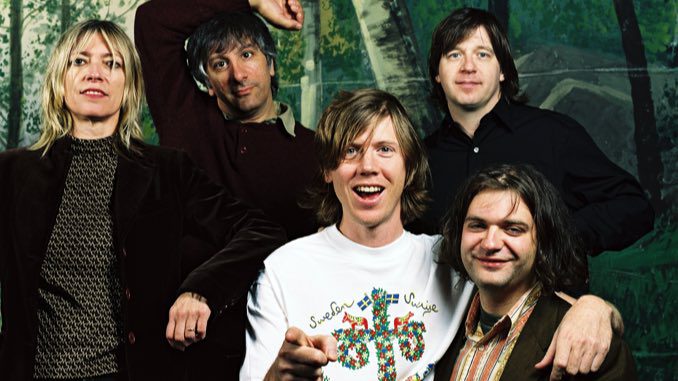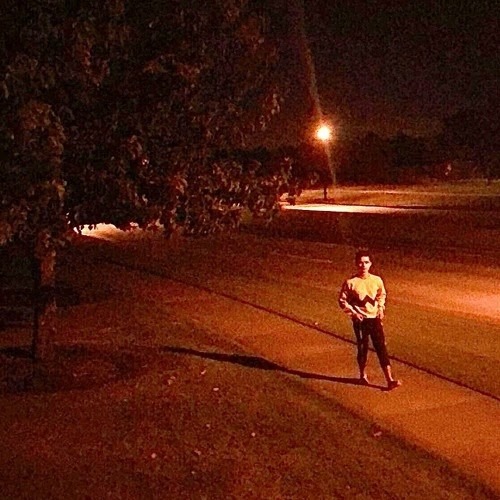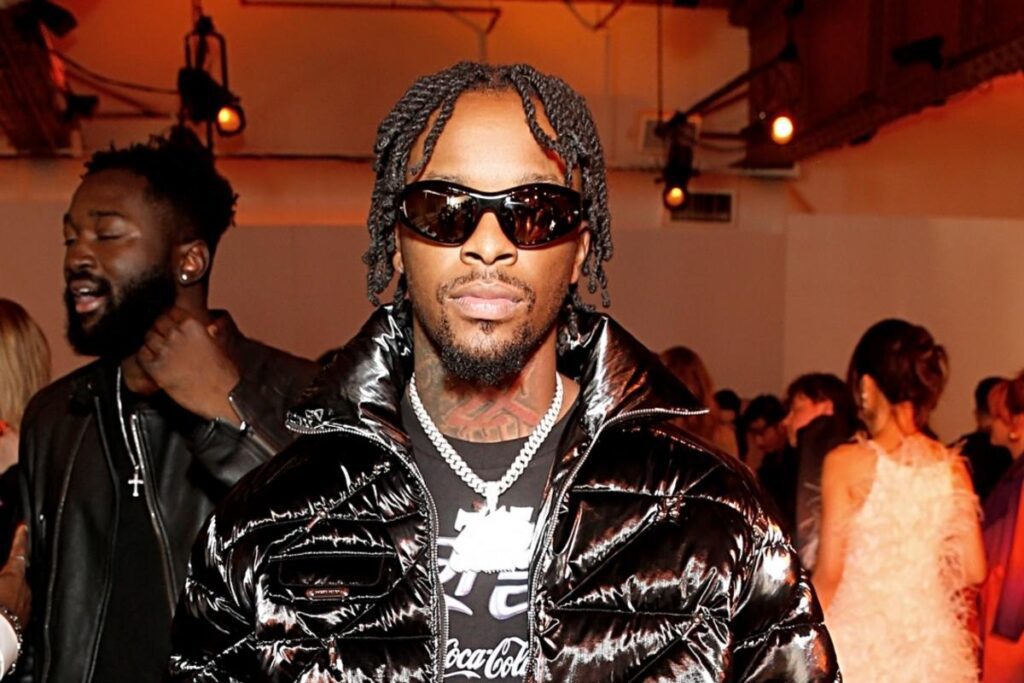After spending the 1980s cutting their teeth as key players in New York City’s thriving no wave scene, Sonic Youth slowly made a name for themselves as one of the most challenging and ambitious rock groups of the past 50 years. Kim Gordon, Thurston Moore, Lee Ranaldo and Steve Shelley are renowned for their non-traditional techniques and inimitable cool. Thanks to the quartet’s status as notably alluring weirdos, the act’s legacy is to the ‘90s as The Velvet Underground’s is to the ‘60s.
I discovered Sonic Youth through the videogame Rock Band 2 as an 11-year-old, so I was surprised when I later learned that they got their start toying with actively disorienting tunings and sadistic playing styles. The band’s 1981 debut is at once minimal and brutal, pairing propulsive arrangements with a dry post-punk attitude. Confusion Is Sex and Evol are similarly avant-garde records, built around unsettling storytelling, jagged spurts of noise, and dirge-like rhythms. Of the band’s early output, though, the most intimidating is Bad Moon Rising-a blistering, scary album with an apt title. Although diving into the first five years of Sonic Youth’s recorded music isn’t easy, those four albums hold up as some of the most influential experimental releases of all time.
Around 1987, things started to get a bit more accessible. Sonic Youth’s fifth full-length, Sister, embraced cleaner production and prettier soundscapes, with some alternative tracks scattered among the more characteristically visceral cuts. That record laid the framework for the angsty, but engaging style they explored on classics like Daydream Nation, Goo, Dirty and a handful of other time-tested art-rock masterpieces. Some of the band’s mid-to-late-career music is still pretty out there, but the work they released during the latter 20 years of their run tends to be their most monumental.
Sonic Youth’s identity was heavily tied to Gordon and Moore’s long-term romantic partnership. Unfortunately, that meant the couple’s 2011 divorce ushered in the act’s breakup. However, all four former members have continued to put out music. Moore, Gordon and Ranaldo have successful and exciting solo careers, while Shelley has drummed on records from Disappears, M. Ward and Jessica Lea Mayfield. Moore has suggested that the band is just on an indefinite hiatus while he and Gordon remain on bad terms, but other members have stated that they’re done for good. Regardless, they left behind 15 studio albums, countless bootlegs and a YouTube rabbit hole’s worth of interviews that paved the way for an entire generation of musical oddballs to come. So ahead of the band’s rarities compilation, In/Out/In, out now on Three Lobed Recordings, we’re looking back at the 10 best Sonic Youth songs, from their frantic ‘80s outings with Lydia Lunch to their mid-2000s hits.
10. “The Burning Spear”
Sonic Youth’s self-titled 1981 debut EP was largely panned at the time of its release, but it is still looked back on as a seminal no wave record. The band recorded five tracks in Radio City Music Hall, which were released on Glenn Branca’s imprint, Neutral Records. The EP is centered on a milky sonic palette and post-punk rhythms. Its opening track, “The Burning Spear,” is especially emblematic of the band’s early sound, driven by a disco drum groove, churning bassline and shouted refrain. You can hear the influence of Moore’s prior band, The Coachmen, on the song, although it’s palpably more frantic and urgent. In many ways, “The Burning Spear” brings to mind early Joy Division, if that band was impacted by the high-energy grit of the downtown art scene instead of the dreary factories of Manchester.
9. “100%”
Sonic Youth were a full-blown grunge act when they dropped Dirty in 1991. Hot on the heels of a tour with Nirvana, the band hit the studio with producer Butch Vig to record what would become one of their most iconic albums. The single “100%” plays like a relic of its era. Trebly feedback rides atop a lurching beat that never quite settles into a pocket. “I stick a knife in my head thinking ‘bout your eyes / But now that you’ve been shot dead, I got a new surprise,” Moore threateningly sings in a sardonic, cocky tone. The song peaked at number four on the Alternative Airplay chart, ending up a shockingly intense radio hit. Thanks to their scrappy roots, Sonic Youth were well-suited for the ‘90s rock boom. “100%” perfectly captures their marketable edginess.
8. “Death Valley ‘69”
Bad Moon Rising isn’t an inviting record, but it is definitely a badass record. Sonic Youth’s second official studio album drew inspiration from American darkness (think the Manson Family, Satanism and European colonization). “Death Valley ‘69” is a crucial outtake from that release, thanks to a guest feature from Teenage Jesus and The Jerks provocateur Lydia Lunch. Screamy and dissonant, it’s an unnerving track that captures Sonic Youth’s penchant for morbid vehemence at its finest. “I got sand in my mouth / Deep in the valley / In the trunk of an old car / In the back of a Chevy,” Moore and Lunch semi-harmonize in the latter half of the song. “Death Valley ‘69” sounds like what would happen if five fictional horror movie murderers collaborated on an experimental rock jam.
7. “Dirty Boots”
I’m not sure that I would have fallen in love with underground music if I hadn’t watched the “Dirty Boots” music video as an eighth grader. The Tamra Davis-directed visual features a bunch of grimy, flannel-clad teenagers moshing around at the dingiest basement show you could possibly air on MTV. The song itself is similarly slacker-y-pounding mid-tempo drums lay the framework for wiry shoegaze riffs and a belted, simplistic chorus. “Dirty Boots” was selected as the opening track on Sonic Youth’s first Geffen release, but don’t get it twisted-it’s one of the greatest outsider anthems that’s ever been laid to tape.
6. “Teen Age Riot”
Daydream Nation isn’t just one of the most important alternative-rock records of the ‘80s, it’s one of the greatest releases in the genre ever. “Teen Age Riot” sets the scene with an almost-seven-minute banger that morphs from ethereal noodling to searing slacker rock. Across the track, the band masterfully shred in tandem, their dayglow melodies supported by pounding percussion. “Looking for a ride to a secret location / Where the kids are setting up a free-speed nation, for you,” Moore sings, abstractly encapsulating the essence of pre-internet cool in his spunky verse. Sonic Youth were older than many of their peers for the duration of their career, but their songwriting and attitude often capture the ennui of youth. “Teen Age Riot” displays that tendency at its finest, the rare art-rock track that will get you playing air guitar along with it.
5. “Incinerate”
It’s not often that a band drop a late-in-the-game album that is as good as anything they’ve put out before, but 2006’s Rather Ripped is one of the most appealing releases in Sonic Youth’s entire discography. Centered on a galloping tom groove and fuzzed-out guitar plucking, “Incinerate” is exactly the song that comes to mind when I see a still photo of the quartet, with their shaggy haircuts and undeniable East Coast disposition. “You doused my soul with gasoline / You flicked a match into my brain,” Moore’s smokey voice sings over twangy, dovetailing stringwork. You can sense the influence of the act’s peers on this track more than most in their catalog. It brings to mind contemporaries like My Bloody Valentine, Ride and Dinosaur Jr.
4. “Schizophrenia”
The release of Sister marked a turning point in Sonic Youth’s career. Although the album still brims with overcast cacophony, it sets itself apart from the records that came before it by flirting with more tangible structures and arrangements. Its opening track, “Schizophrenia,” is inspired by Gordon’s brother Keller’s struggles with mental illness. In the song, Moore tells a semi-fictitious story about visiting an old friend and meeting his sister, who is suffering from paranoia and delusion. “She said Jesus had a twin who knew nothing about sin / She was laughing like crazy at the trouble I’m in / Her light eyes were dancing, she is insane,” he recounts in the first verse. It’s one of the first Sonic Youth songs that tells a linear story-one that feels even more tragic and poignant after reading Gordon’s words on Keller in her 2015 autobiography, Girl In A Band.
3. “Silver Rocket”
Sonic Youth’s more commercial period didn’t find them shying away from their fondness for evil energy. “Silver Rocket” opens with an agitated melody before it gives way to speedy post-hardcore. It eventually disintegrates into a screeching, nihilistic stew of sound before the band leap back into one last curt, unexpected verse. If it weren’t for Nick Sansano’s pristine production, this song would be as ferocious and dense as anything on Bad Moon Rising or Evol.
2. “Mary-Christ”
Thanks to its unforgettable album art, Goo is probably the most famous Sonic Youth album. However, that doesn’t mean it isn’t jam-packed with grimy, viscous rippers. “Mary-Christ” begins with the eerie clatter of church bells, which quickly give way to uptempo, whammied-out noise punk. “Talking to a punker priest just doggin’ the breeze ‘bout bein’ a tree / Along comes Mary Christ skatin’ light on ice says there’s no one,” Moore sneers on its opening lines, as Gordon’s distorted voice ad-libs in the background. It’s a flawless example of the type of Sonic Youth track that might not totally make sense to someone outside the band, but absolutely whips nonetheless.
1. “The Empty Page”
“The Empty Page” is the rare Sonic Youth song that allows itself to be fully stripped of pretension, and it’s all the better for it. The Murray Street opener is melodic and mournful, the quartet’s instrumental work cleaner and tamer than usual. There’s still a cryptic poeticism to its lyrics, but it feels more akin to the wistful folk songwriting Moore explored on his 2011 solo release Demolished Thoughts than it does to anything in the Sonic Youth universe. It’s far from the act’s most intentionally groundbreaking composition, but it’s the rare sing-along moment from a band that typically aim to perplex their listeners, rather than please them. Part of the fun of being a Sonic Youth fan is learning to embrace the chaos, but “The Empty Page” proves that they’re equally amazing artists when they simply allow themselves to mellow out.
Ted Davis is a culture writer, editor and musician from Northern Virginia, currently based in Los Angeles. He is the Music Editor for Merry-Go-Round Magazine. On top of Paste, his work has appeared in Pitchfork, FLOOD Magazine, Aquarium Drunkard, The Alternative, Post-Trash, and a slew of other podcasts, local blogs and zines. You can find Ted on Twitter at @tddvsss.




